History
First recorded in 1192, the church of San Macuto has had several owners at different times. In the second half of the 13th century it was dependent on San Marcello al Corso, then later it belonged to the Dominicans from the neighbouring Santa Maria sopra Minerva (confirmed by Pope Nicholas III in 1279). In the year 1422 it was described as a parish church. Pope Leo X joined the parish with that of St. Peter's Basilica in 1516, giving it to the Fraternity of Bergamo in 1539.
The Bergamo monks changed the saint it was dedicated to from Bartholemew to Alexander of Bergamo and the church got a new façade around 1560. The façade was a project of the Ferraran architect Giovanni Alberto Galvani and it was partially reconstructed 1577−1585 to the design of Francesco da Volterra.
Following a decision by Pope Benedict XIII, the Bergamo monks bequeathed their church to the Jesuits from the neighbouring palazzo in 1725−1726. They moved to a church then called Santa Maria della Pietà instead, and changed its name to Santi Bartolomeo ed Alessandro dei Bergamaschi (on the Piazza Colonna). The Jesuits rededicated the church to Saint Malo, following the vicissitudes of history together with the adjacent palazzo (later called Palazzo Gabrielli-Borromeo), which had longer been known as belonging to the Jesuits. It served as the church for the Pontifical Roman Seminary, the Board of Ecclesiastical Nobles, the Collegium Germanicum et Hungaricum, and the Pontifical Gregorian University (1873−1930). Since 1942 it has been part of the Collegio Bellarmino, formerly belonging to the Roman Province of Jesuits, now an international home for the religious order.

The Pontifical Gregorian University, is a higher education ecclesiastical school located in Rome, Italy.
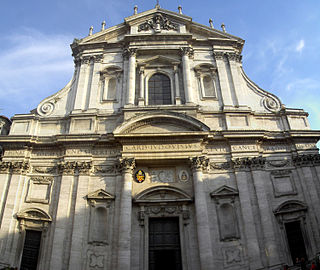
The Church of St. Ignatius of Loyola at Campus Martius is a Roman Catholic titular church, of deaconry rank, dedicated to Ignatius of Loyola, the founder of the Society of Jesus, located in Rome, Italy. Built in Baroque style between 1626 and 1650, the church functioned originally as the chapel of the adjacent Roman College, which moved in 1584 to a new larger building and was renamed the Pontifical Gregorian University.

The properties of the Holy See are regulated by the 1929 Lateran Treaty signed with the Kingdom of Italy. Although part of Italian territory, some of them enjoy extraterritoriality similar to those of foreign embassies.

The Church of the Gesù is the mother church of the Society of Jesus (Jesuits), a Catholic religious order. Officially named Chiesa del Santissimo Nome di Gesù all'Argentina, its façade is "the first truly baroque façade", introducing the baroque style into architecture. The church served as a model for innumerable Jesuit churches all over the world, especially in the Americas. Its paintings in the nave, crossing, and side chapels became models for Jesuit churches throughout Italy and Europe, as well as those of other orders. The Church of the Gesù is located in the Piazza del Gesù in Rome.
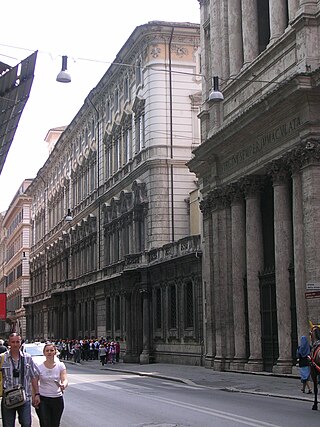
The Doria Pamphilj Gallery is a large private art collection housed in the Palazzo Doria Pamphilj in Rome, Italy, between Via del Corso and Via della Gatta. The principal entrance is on the Via del Corso. The palace façade on Via del Corso is adjacent to a church, Santa Maria in Via Lata. Like the palace, it is still privately owned by the princely Roman family Doria Pamphili. Tours of the state rooms often culminate in concerts of Baroque and Renaissance music, paying tribute to the setting and the masterpieces it contains.
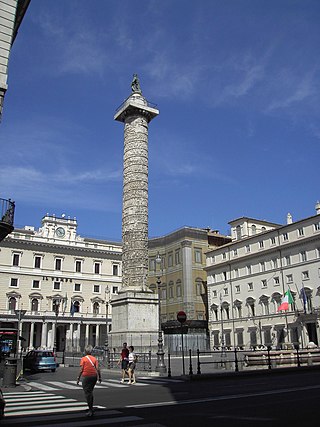
Colonna is the 3rd rione of Rome, identified by the initials R. III and located at the city's historic center in Municipio I. It takes its name from the Column of Marcus Aurelius in the Piazza Colonna, the rione's main square.
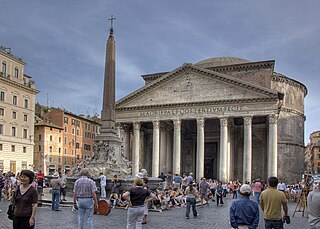
Pigna is the 9th rione of Rome, identified by the initials R. IX, and belongs to the Municipio I. The name means "pine cone" in Italian, and the symbol of the rione is the colossal bronze pine cone standing in the middle of the homonymous fountain. The fountain, which was initially located in the Baths of Agrippa, now decorates a vast niche in the wall of the Vatican facing the Cortile della Pigna, located in Vatican City.

The Basilica of San Petronio is a minor basilica and church of the Archdiocese of Bologna located in Bologna, Emilia Romagna, northern Italy. It dominates Piazza Maggiore. The basilica is dedicated to the patron saint of the city, Saint Petronius, who was the bishop of Bologna in the fifth century. Construction began in 1390 and its main facade has remained unfinished since. The building was transferred from the city to the diocese in 1929; the basilica was finally consecrated in 1954. It has been the seat of the relics of Bologna's patron saint only since 2000; until then they were preserved in the Santo Stefano church of Bologna.

San Marcello al Corso, a church in Rome, Italy, is a titular church whose cardinal-protector normally holds the (intermediary) rank of cardinal-priest.

Pacentro is a comune of 1,279 inhabitants of the province of L'Aquila in Abruzzo, Italy. It is a well-preserved historic medieval village located in central Italy, several kilometers from the City of Sulmona about 170 kilometres (110 mi) east of Rome. It is a member of the I Borghi più belli d'Italia association.

The Roman College was a school established by St. Ignatius of Loyola in 1551, just 11 years after he founded the Society of Jesus (Jesuits). It quickly grew to include classes from elementary school through university level and moved to several successive locations to accommodate its burgeoning student population. With the patronage of Pope Gregory XIII, the final seat of the Roman College was built in 1584 near the center of Rome's most historic Pigna district, on what today is called Piazza del Collegio Romano, adding the church of St. Ignatius in 1626, and a renowned observatory in 1787. The college remained at this location for 286 years until the revolutionary Capture of Rome in 1870.
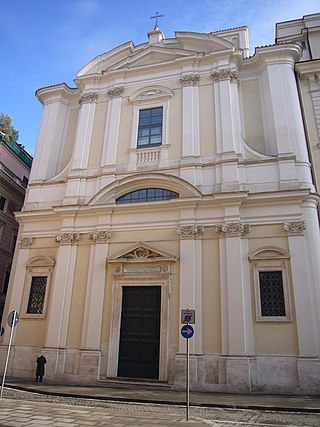
The Basilica di Sant'Apollinare alle Terme Neroniane-Alessandrine is a titular church in Rome, Italy, dedicated to St Apollinare, the first bishop of Ravenna.

San Fedele is a Jesuit church in Milan, northern Italy. It is dedicated to St. Fidelis of Como, patron of the Catholic diocese of Como. Presently it remains a parish church, owned by the Jesuit order, though focusing on religious works.
The Pontifical Roman Major Seminary is the major seminary of the Diocese of Rome. It is located at the Archbasilica of Saint John Lateran. Since 2017, the rector of the seminary has been Gabriele Faraghini, a priest of the Little Brothers of Jesus Caritas.

San Gaetano, also known as Santi Michele e Gaetano, is a Baroque church in Florence, Italy, located on the Piazza Antinori, entrusted to the Institute of Christ the King Sovereign Priest.

The Palazzo Gabrielli-Borromeo is a palazzo in Rome, Italy. It is located in Via del Seminario, between piazza di Sant'Ignazio and the Pantheon in the ancient Campus Martius and in the second sector of the present-day Colonna rione, not far from Via del Corso.

Pontifical Roman Athenaeum S. Apollinare is a former pontifical university in Rome, named after St. Apollinaris of Ravenna. Its facilities are now occupied by the Pontifical University of the Holy Cross.

Volterra Cathedral is a Roman Catholic cathedral in Volterra, Italy, dedicated to the Assumption of the Virgin Mary. It is the seat of the bishop of Volterra.
San Pietro is a Roman Catholic church in central Piacenza, Emilia Romagna, Italy. The church was built over the site of an ancient church titled San Pietro in Foro.

The Chiesa del Gesù is a Catholic church located in Alcamo, in the province of Trapani, Sicily, southern Italy. It is the second largest church in Alcamo, after the basilica di Santa Maria Assunta.



















